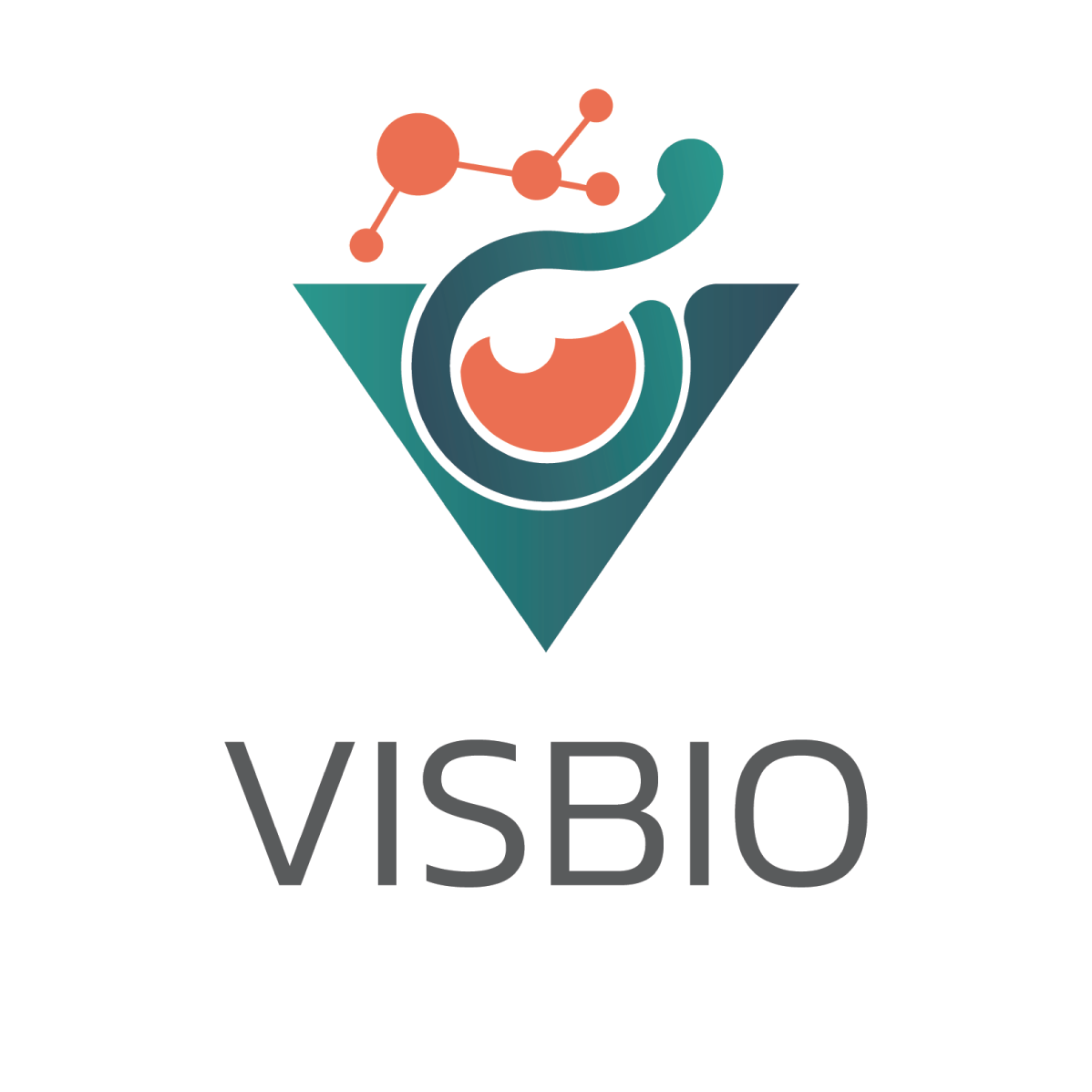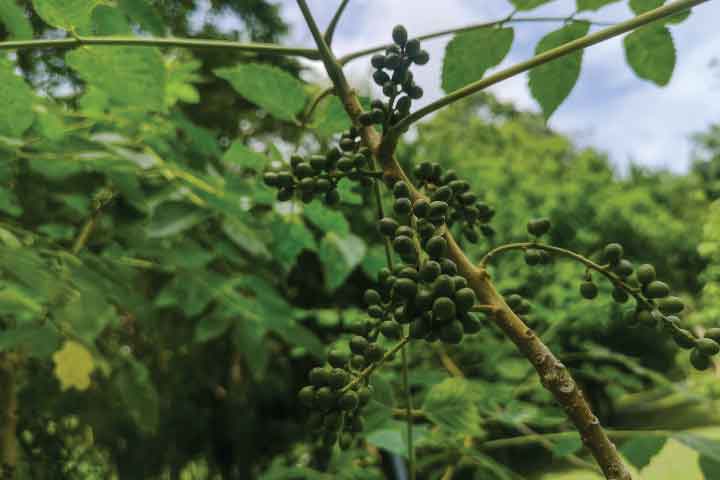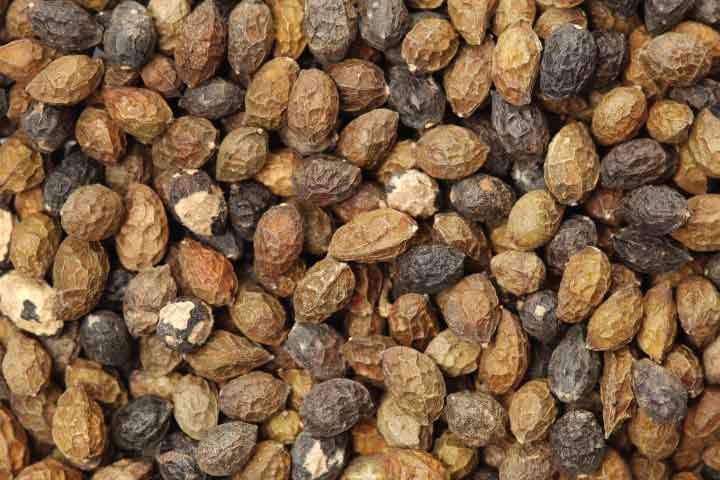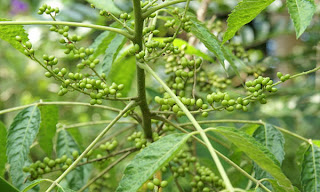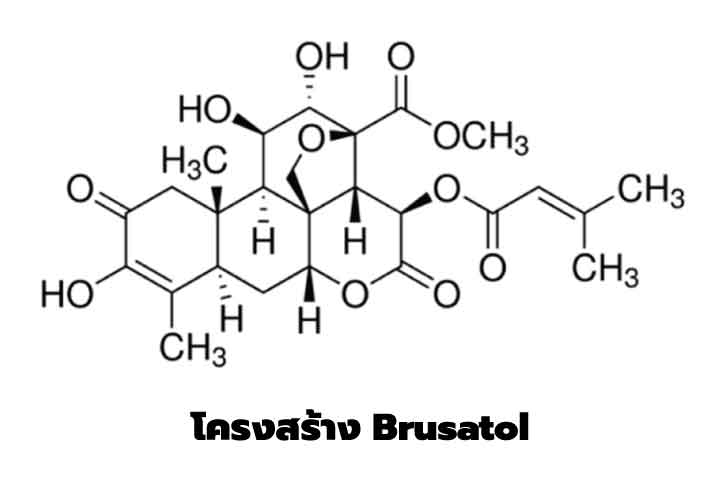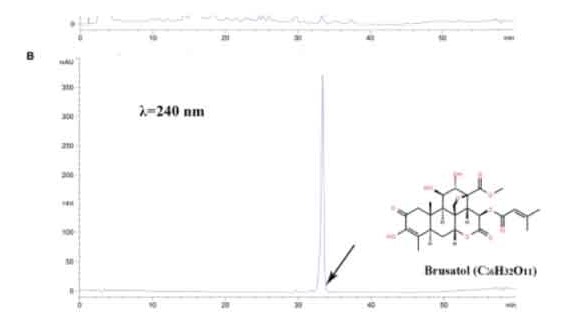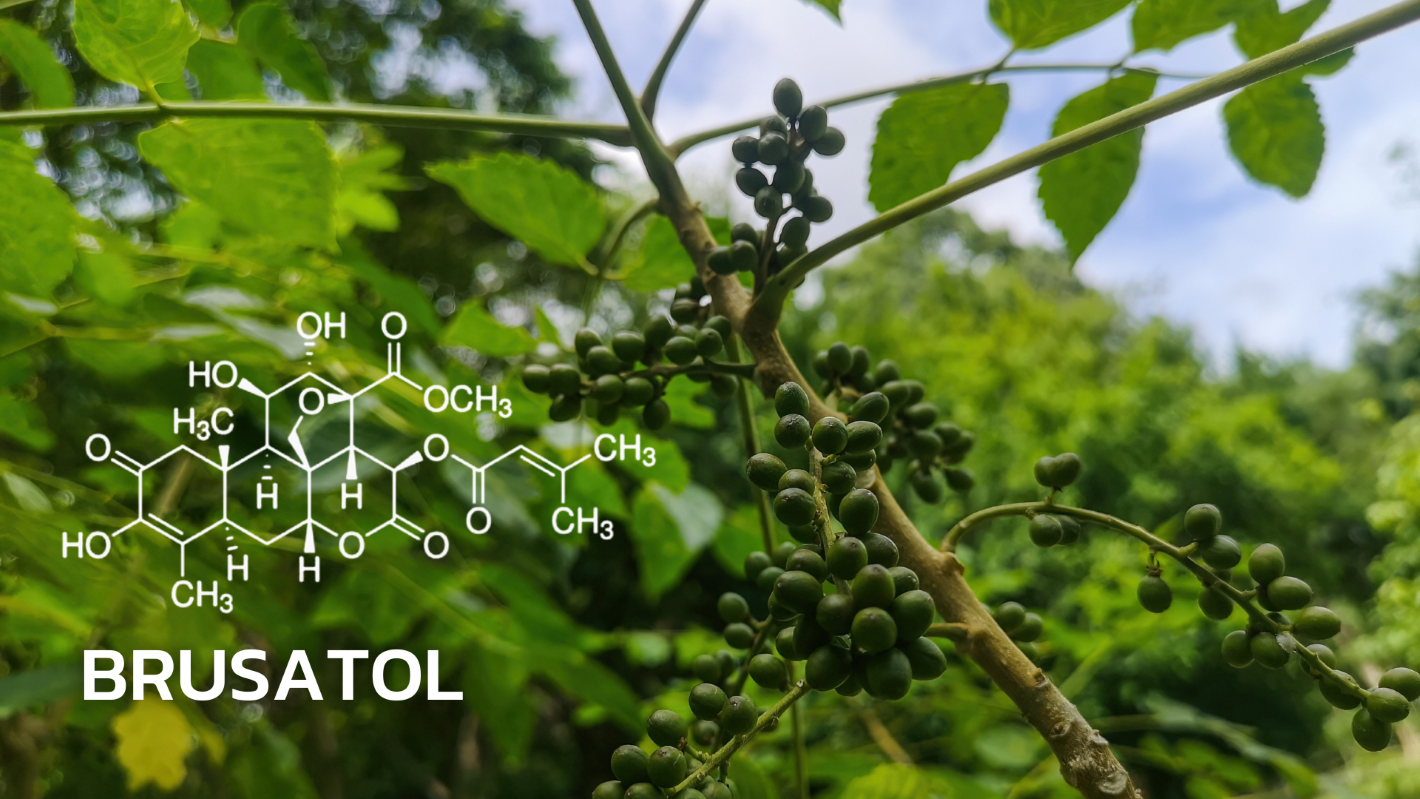
Service information for testing biomarker levels of Brusatol using HPLC Technique.
VISBIO Co., Ltd. offers testing and analysis services for biomarker levels of Brusatol in all products. Brusatol is a bioactive compound found in Chinese herbal medicine and has been used for treating various conditions, including malaria, antimicrobial, anti-inflammatory, antiviral, and anticancer properties. Currently, extensive research is being conducted, leading to the development of Brusatol extracts for various medical applications, particularly cancer treatment, as seen in numerous studies. Therefore, analyzing and ensuring the quality of Brusatol in Chinese herbal medicine is crucial, and HPLC is a commonly used technique for this purpose.
Brucea Javanica: What Is It?
Brucea Javanica, also known as “Ratchadat” in Thai, is native to the Asian continent and can be found in all regions of Thailand. It is a type of traditional herbal plant with the scientific name Brucea javanica (L.) Merr. The plant is referred to by different names in local languages, such as “Ya Gae Hak Khom” in Chiang Mai, “Dee Khon” in Ubon Ratchathani, “Phayadaphak” in Trat, and “Soy Dao” in Chanthaburi, among others. Brucea Javanica is a shrub or small-sized tree that can be found in secondary forests and open areas, and it is known for its resilience to various weather conditions.
Key Chemical Compounds of Brucea Javanica
“Ratchadat or Brucea Javanica is a widely used herbal plant in many countries, such as in Chinese traditional medicine, Thai herbal remedies, Indonesia, and the Philippines. It is used for treating fever, indigestion, abdominal discomfort, nausea, stomachache, diarrhea, as well as for its anti-malarial, anti-bacterial, anti-inflammatory, anti-viral, and anti-cancer properties. Additionally, ongoing research is being conducted to utilize its potential in cancer treatment, particularly its ability to inhibit cancer cell growth.
However, due to the limited solubility and poor bioavailability of the active compounds in Brucea Javanica, there have been efforts to develop methods to enhance their absorption and utilization in the body, addressing a limitation in its use for various medical conditions.
Key compounds found in Brucea Javanica include:
- Quassinoids such as Brusatol, Bruceine, Bruceanic acids, Javanicolide, Javanic acids A-B, Yadanzioside, 20-hydroxyyadanzigan, Bruceantin, Bruceantinol, Bruceantinosides, Bruceoside, Demethyl-dehydrobrusatol, and more.
- Alkaloids like Bruceolline and Bruceacanthinoside.
- Triterpenes including Brujavanone A-N.”
Properties of Brucea Javanica
The benefits of Brucea Javanica can be derived from various parts of the plant, including the roots, leaves, flowers, fruits, and seeds, for the treatment and relief of various conditions, as follows:
- Stem: Boiling the roots and drinking the decoction can help alleviate jaundice and yellowing of the skin.
- Leaves: The bitter leaves can be pounded with limestone and then applied topically to treat scabies, itching, and insect bites.
- Fruits: The ripe fruits, known for their bitterness, can be used to relieve constipation, alleviate abdominal discomfort, reduce nausea, and treat vomiting. They are also considered a tonic and can aid in nutrient absorption, help with digestion, and treat diarrhea, dysentery, and malaria. To consume, crack the peel of the fruit and boil it, then drink the decoction (5 fruits at a time).
- Dried Seeds: The bitter-tasting dried seeds can be ground and used to treat scabies by applying the resulting paste to affected areas. They are also utilized to address intestinal issues, such as treating dysentery and promoting bowel movements.
- Roots: Boiling the roots and consuming the decoction can serve as a treatment for fever, colic, abdominal pain, muscle pain, and can even be chewed with betel leaves to alleviate coughs.
- Both Roots and Seeds: Both parts are used to treat malarial fever.
Precautions for Using Brucea Javanica
Brusa Javanica is an herb that contains a low level of toxicity. Therefore, it should be used in the recommended quantities as specified in various medicinal formulations. It is important not to use it excessively or continuously for an extended period. Additionally, Brucea Javanica should not be used in large quantities, especially in children, pregnant women, and individuals with gastrointestinal abnormalities and intestinal disorders.
What Is Brusatol?
Brusatol is a type of compound found in Brucea Javanica, which is commonly used in various research studies. It has the molecular formula C26H32O11 and is primarily located in the seeds of Brucea Javanica. Brusatol is an important substance belonging to the Quassinoids group. It is used for the treatment of malaria and cancer. Over the years, there has been extensive research on its properties, including its ability to combat malaria, reduce inflammation, and combat viruses. Notably, there has been significant research on its anti-cancer properties. Studies conducted both in laboratory settings and living organisms have revealed that Brusatol possesses the ability to inhibit metastasis and the growth of cancer cells, such as those found in liver, colorectal, and lung cancers. Brusatol can enhance the sensitivity of cancer cells to chemotherapy by suppressing the expression of Nuclear factor erythroid 2-related factor 2 (Nrf2), a transcription factor that plays a role in regulating the body’s antioxidant response.
Brucea Javanica Extract in the Pharmaceutical Industry
Brucea Javanica, also known as Ratchadat, is a type of herbal plant with various active compounds. It has numerous medicinal properties, including its effectiveness in treating conditions such as fever, indigestion, nausea, abdominal pain, diarrhea, malaria, inflammation, viral infections, bacterial infections, and even cancer. As a result, there has been ongoing research to extract and develop pharmaceutical drugs from Brucea Javanica, especially for the treatment of various diseases, notably cancer. This is evident from the many research studies conducted, such as those investigating its toxicity against cancer cells in oral and leaf extracts of Brucea Javanica and the development of crude extracts from Brucea Javanica that induce toxicity in white blood cells, among others.
Report Example: Brusatol Analysis Using HPLC Technique
Graph showing the chromatogram of Brusatol, the area under the graph can be used to calculate the amount of Brusatol by comparing it with the standard substance.
Literature:
- ฐานข้อมูลเครื่องยาสมุนไพร, คณะเภสัชศาสตร์ มหาวิทยาลัยอุบลราชธานี.
- ดร.นิจศิริ เรืองรังษี, ธวัชชัย มังคละคุปต์, หนังสือสมุนไพรไทย เล่ม 1, ราชดัด (Ratchadat).
- หนังสือสมุนไพรสวนสิรีรุกขชาติ, คณะเภสัชศาสตร์ มหาวิทยาลัยมหิดลม, ราชดัด.
- ดร.วิทย์ เที่ยงบูรณธรรม, หนังสือพจนานุกรมสมุนไพรไทย, ฉบับพิมพ์ครั้งที่ 5, ราชดัด.
- วิทยา บุญวรพัฒน์, หนังสือสารานุกรมสมุนไพรไทย-จีนที่ใช้บ่อยในประเทศไทย, ราชดัด.
- มีคณา, นิตยสารธรรมลีลา, ฉบับที่ 162 มิถุนายน 2557.
- สุวรรณา เสมศรี, นวลจันทร์ แก้วอุดร, นันทภรณ์ ใจภักดี, นภาพร ชรชาญ, ณัฐริณี หอระตะ, ผลของสารสกัดหยาบเอทานอลจากผลของราชดัด (Brucea amarissma) ต่อความเป็นพิษต่อเซลล์ และการแสดงออกของโปรตีนวิล์มทูเมอร์วัน ในเซลล์มะเร็งเม็ดเลือดขาวเพาะเลี้ยงชนิด K562, วารสารเทคนิคการแพทย์เชียงใหม่, ปีที่ 47 ฉบับที่ 1 มกราคม 2557 : 45-52.
- Cuendet M, Gills JJ, Pezzuto JM. Brusatol-induced HL-60 cell differentiation involves NF-kappaB activation. Cancer Lett. 2004; 206: 43-50.
- Chen M, Chen R, Wang S, Tan W, Hu Y, Peng X, Wang Y. Chemical components, pharmacological properties, and nanoparticulate delivery systems of Brucea javanica. Int J Nanomedicine. 2013;8:85-92.
- Zhang J, Xu HX, Dou YX, Huang QH, Xian YF, Lin ZX. Major Constituents From Brucea javanica and Their Pharmacological Actions. Front Pharmacol. 2022 Mar 18;13:853119.
- National Center for Biotechnology Information (2022). PubChem Compound Summary for CID 73432, Brusatol. Retrieved December 8, 2022. from https://pubchem.ncbi.nlm.nih.gov/compound/Brusatol.
- Cai, S.J., Liu, Y., Han, S. et al. Brusatol, an NRF2 inhibitor for future cancer therapeutic. Cell Biosci 9, 45 (2019). https://doi.org/10.1186/s13578-019-0309-8.
- Chen, X., Yin, T., Zhang, B., Sun, B., Chen, J., Xiao, T., Wang, B., Li, M., Yang, J., Fan, X.”Inhibitory effects of brusatol delivered using glycosaminoglycan-placental chondroitin sulfate A-modified nanoparticles on the proliferation, migration and invasion of cancer cells”. International Journal of Molecular Medicine 46.2 (2020): 817-827.
